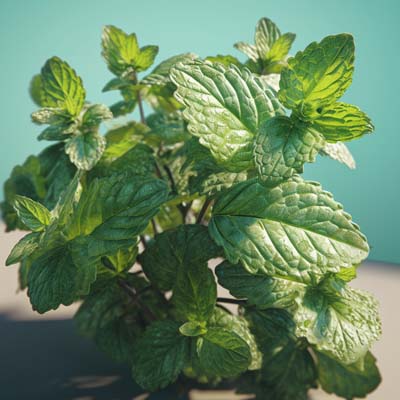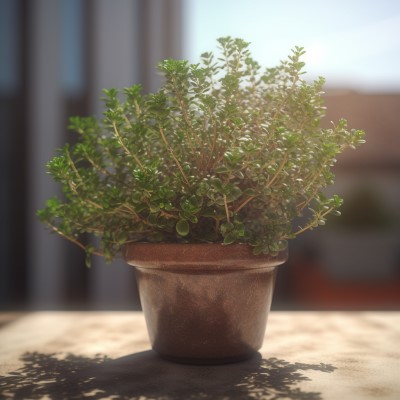Edible Plant Gardening for Kids: A Fun and Tasty Adventure
 Tea is a beloved beverage enjoyed by people of all ages around the world. While most tea is derived from the leaves of the Camellia sinensis plant, there is a world of herbal teas waiting to be discovered. In fact, several plants can be grown and dried to create delightful and flavorful herbal teas. Not only does this provide an opportunity for adults to explore their taste buds, but it can also be a fantastic and educational activity for children.
Tea is a beloved beverage enjoyed by people of all ages around the world. While most tea is derived from the leaves of the Camellia sinensis plant, there is a world of herbal teas waiting to be discovered. In fact, several plants can be grown and dried to create delightful and flavorful herbal teas. Not only does this provide an opportunity for adults to explore their taste buds, but it can also be a fantastic and educational activity for children.
We will explore a selection of plants that can be grown in your backyard or even indoors, and then dried to make aromatic and delicious herbal teas. We will delve into the process of growing, harvesting, and drying these plants, as well as discuss the unique flavors they offer. So, let's embark on this journey of growing plants for tea-making and discover the wonders of nature through the eyes of children.
Several plants that are easy for children to grow in a first garden can be dried and used to make herbal teas that can be enjoyed hot or cold.
Plants that you can grow and dry for tea-making:
- Chamomile: A Soothing and Relaxing Cup of Tea
 Chamomile, with its delicate and daisy-like flowers, is renowned for its calming properties. Growing chamomile in your garden provides an opportunity for children to witness the lifecycle of this beautiful plant. Once harvested, the flowers can be dried and used to make a soothing and aromatic tea. Children can enjoy a cup of chamomile tea before bedtime, promoting a sense of tranquility and aiding in a restful sleep.
Chamomile, with its delicate and daisy-like flowers, is renowned for its calming properties. Growing chamomile in your garden provides an opportunity for children to witness the lifecycle of this beautiful plant. Once harvested, the flowers can be dried and used to make a soothing and aromatic tea. Children can enjoy a cup of chamomile tea before bedtime, promoting a sense of tranquility and aiding in a restful sleep. - Mint: A Refreshing Adventure in Flavor
 Mint, with its vibrant green leaves and invigorating aroma, offers a myriad of flavors to explore. Varieties such as peppermint and spearmint can be grown easily, even in small containers. Children can experiment with different mint leaves to create refreshing and personalized tea blends. The process of drying the leaves and brewing their own mint tea can be a delightful sensory experience for kids, enhancing their understanding of plants and flavors.
Mint, with its vibrant green leaves and invigorating aroma, offers a myriad of flavors to explore. Varieties such as peppermint and spearmint can be grown easily, even in small containers. Children can experiment with different mint leaves to create refreshing and personalized tea blends. The process of drying the leaves and brewing their own mint tea can be a delightful sensory experience for kids, enhancing their understanding of plants and flavors. - Lemon Verbena: A Lemony Zest in Every Sip
 Lemon verbena, with its vibrant green leaves and intense lemony scent, offers a citrusy and aromatic tea that children may find delightful. Growing lemon verbena plants allows kids to observe the growth and care required for this herb. Once the leaves are harvested and dried, they can be steeped to create a refreshing and fragrant cup of lemon verbena tea. The lemony flavor of this tea is sure to appeal to children, and they can even experiment with combining it with other herbs to create unique and personalized tea blends. Lemon verbena tea provides a burst of flavor and a refreshing experience, making it a favorite choice for tea enthusiasts of all ages.
Lemon verbena, with its vibrant green leaves and intense lemony scent, offers a citrusy and aromatic tea that children may find delightful. Growing lemon verbena plants allows kids to observe the growth and care required for this herb. Once the leaves are harvested and dried, they can be steeped to create a refreshing and fragrant cup of lemon verbena tea. The lemony flavor of this tea is sure to appeal to children, and they can even experiment with combining it with other herbs to create unique and personalized tea blends. Lemon verbena tea provides a burst of flavor and a refreshing experience, making it a favorite choice for tea enthusiasts of all ages. - Lemon Balm: A Citrusy Delight (Approx. 200 words)
 Lemon balm, with its gentle lemon fragrance, offers a refreshing and citrusy twist to herbal tea. The leaves of lemon balm can be dried and steeped to create a soothing and aromatic infusion. Growing lemon balm in your garden provides an opportunity for children to experience the joy of cultivating and nurturing a plant. They can learn about the importance of sunlight, water, and care in the plant's growth process. Harvesting the leaves and drying them allows children to actively participate in the tea-making process, fostering a sense of accomplishment and pride. A cup of lemon balm tea can be a delightful and calming treat for kids, offering a mild lemon flavor that they may appreciate.
Lemon balm, with its gentle lemon fragrance, offers a refreshing and citrusy twist to herbal tea. The leaves of lemon balm can be dried and steeped to create a soothing and aromatic infusion. Growing lemon balm in your garden provides an opportunity for children to experience the joy of cultivating and nurturing a plant. They can learn about the importance of sunlight, water, and care in the plant's growth process. Harvesting the leaves and drying them allows children to actively participate in the tea-making process, fostering a sense of accomplishment and pride. A cup of lemon balm tea can be a delightful and calming treat for kids, offering a mild lemon flavor that they may appreciate. - Basil: Fragrance and Flavor in a Cup
 Known for its culinary uses, basil is a versatile herb that can also be transformed into a delightful tea. With its slightly spicy and sweet taste, dried basil leaves make a flavorful and aromatic infusion. Kids can enjoy the process of growing basil, harvesting the leaves, and then drying them to create their own basil tea. Sipping on a cup of basil tea can introduce them to a whole new world of herbal flavors.
Known for its culinary uses, basil is a versatile herb that can also be transformed into a delightful tea. With its slightly spicy and sweet taste, dried basil leaves make a flavorful and aromatic infusion. Kids can enjoy the process of growing basil, harvesting the leaves, and then drying them to create their own basil tea. Sipping on a cup of basil tea can introduce them to a whole new world of herbal flavors. - Calendula: A Subtle Floral Delight
 Calendula, with its vibrant orange and yellow petals, adds a touch of sunshine to any garden. These petals can be dried and brewed to make a mild and pleasant herbal tea. Children can witness the beauty of the calendula plant as it blooms, and then participate in the drying process to create their own cup of floral tea. The subtle flavors and vibrant colors of calendula tea are sure to captivate their senses.
Calendula, with its vibrant orange and yellow petals, adds a touch of sunshine to any garden. These petals can be dried and brewed to make a mild and pleasant herbal tea. Children can witness the beauty of the calendula plant as it blooms, and then participate in the drying process to create their own cup of floral tea. The subtle flavors and vibrant colors of calendula tea are sure to captivate their senses. - Dill: An Aromatic Adventure
 Dill, with its feathery leaves and unique flavor, offers a distinct taste profile that kids may find interesting. The leaves of the dill plant can be dried and used to make an aromatic and flavorful herbal tea. Growing dill in the garden can be a fascinating experience for children, as they witness the growth of this herb and actively participate in its care. The reward comes when they harvest the leaves and transform them into a cup of dill tea, discovering a taste that is both intriguing and refreshing.
Dill, with its feathery leaves and unique flavor, offers a distinct taste profile that kids may find interesting. The leaves of the dill plant can be dried and used to make an aromatic and flavorful herbal tea. Growing dill in the garden can be a fascinating experience for children, as they witness the growth of this herb and actively participate in its care. The reward comes when they harvest the leaves and transform them into a cup of dill tea, discovering a taste that is both intriguing and refreshing. - Lavender: Fragrance and Serenity in a Cup
 Lavender, with its beautiful purple flowers and enchanting scent, is not only pleasing to the eye but also offers a sense of calm and relaxation. Drying lavender flowers and using them to make herbal tea can be a wonderful sensory experience for children. Growing lavender in your garden allows kids to witness the transformation from buds to fully bloomed flowers. They can participate in the harvesting and drying process, and once the flowers are ready, they can enjoy the aroma and flavor of lavender tea. Sipping on a cup of lavender tea can provide a moment of serenity and tranquility, creating a soothing ritual for children to unwind and find inner peace. When I make lavender tea, I use the lavender sparingly and only steep it for 4 minutes. Then I mix it with a bit of honey -- if you use too much lavender or steep too long, it can turn out tasting bitter!
Lavender, with its beautiful purple flowers and enchanting scent, is not only pleasing to the eye but also offers a sense of calm and relaxation. Drying lavender flowers and using them to make herbal tea can be a wonderful sensory experience for children. Growing lavender in your garden allows kids to witness the transformation from buds to fully bloomed flowers. They can participate in the harvesting and drying process, and once the flowers are ready, they can enjoy the aroma and flavor of lavender tea. Sipping on a cup of lavender tea can provide a moment of serenity and tranquility, creating a soothing ritual for children to unwind and find inner peace. When I make lavender tea, I use the lavender sparingly and only steep it for 4 minutes. Then I mix it with a bit of honey -- if you use too much lavender or steep too long, it can turn out tasting bitter! - Rosemary: A Robust and Aromatic Infusion
 Rosemary, with its woody stems and distinct aroma, is a herb that adds depth and flavor to various culinary dishes. However, it can also be dried and used to make a robust and aromatic herbal tea. Growing rosemary in your garden allows children to witness the resilience and hardiness of this herb. They can engage in the harvesting and drying process, and once the leaves are ready, they can enjoy the intense and fragrant flavors of rosemary tea. The unique taste of rosemary may intrigue kids, and they can explore different combinations with other herbs to create their own tea blends. Sipping on a cup of rosemary tea can be invigorating and uplifting, awakening the senses and providing a delightful herbal experience.
Rosemary, with its woody stems and distinct aroma, is a herb that adds depth and flavor to various culinary dishes. However, it can also be dried and used to make a robust and aromatic herbal tea. Growing rosemary in your garden allows children to witness the resilience and hardiness of this herb. They can engage in the harvesting and drying process, and once the leaves are ready, they can enjoy the intense and fragrant flavors of rosemary tea. The unique taste of rosemary may intrigue kids, and they can explore different combinations with other herbs to create their own tea blends. Sipping on a cup of rosemary tea can be invigorating and uplifting, awakening the senses and providing a delightful herbal experience. - Thyme: Flavorful Herb Infusion:
 Thyme, with its tiny leaves and aromatic essence, offers a flavorful and herbal tea that can be enjoyed by children. There are various thyme varieties available, each with its distinct flavor profile. Growing thyme plants in your garden provides an opportunity for kids to explore the diversity of this herb and witness its growth process. Harvesting the leaves and drying them allows children to actively engage in the tea-making process. Once the leaves are dried, they can be infused to create a flavorful and herbal cup of thyme tea. Kids can experiment with different thyme varieties and combinations with other herbs to create their own unique tea blends. The process of blending and brewing their own thyme tea can be a creative and exciting experience for children, as they discover the various flavors and aromas that can be derived from this versatile herb.
Thyme, with its tiny leaves and aromatic essence, offers a flavorful and herbal tea that can be enjoyed by children. There are various thyme varieties available, each with its distinct flavor profile. Growing thyme plants in your garden provides an opportunity for kids to explore the diversity of this herb and witness its growth process. Harvesting the leaves and drying them allows children to actively engage in the tea-making process. Once the leaves are dried, they can be infused to create a flavorful and herbal cup of thyme tea. Kids can experiment with different thyme varieties and combinations with other herbs to create their own unique tea blends. The process of blending and brewing their own thyme tea can be a creative and exciting experience for children, as they discover the various flavors and aromas that can be derived from this versatile herb.
Conclusion:
Growing plants for tea-making provides a wonderful opportunity for children to engage with nature, learn about different plant species, and develop a deeper appreciation for the natural world. The plants mentioned in this blog post, including chamomile, mint, basil, calendula, dill, lemon balm, lavender, lemon verbena, rosemary, and thyme, offer a wide range of flavors and aromas that can be explored and enjoyed.
Through the process of growing, harvesting, and drying these plants, children can actively participate in the tea-making journey. They can witness the life cycle of plants, develop gardening skills, and gain a better understanding of how different plants contribute to the flavors and fragrances in their tea.
Moreover, creating their own herbal tea blends allows children to tap into their creativity and experiment with flavors, fostering a sense of ownership and accomplishment. It also encourages them to explore their senses and develop a more refined palate.
So, why not embark on this exciting adventure of growing plants for tea-making with your children? It's an educational, fun, and rewarding experience that will not only provide delicious and aromatic teas but also cultivate a deeper connection with nature and the world of plants. Let your children savor the joy of growing, harvesting, and brewing their own herbal teas, and watch as their curiosity and love for nature blossom.
Drying Homegrown Herbs for Herbal Tea:
Growing an herb garden with children is a rewarding experience that not only brings joy but also fosters education, skill building, and a deeper connection to nature. As the herbs flourish, the time comes to harvest and preserve their flavors for future use. In this blog post, we will explore the art of drying homegrown herbs for herbal tea, highlighting the benefits, techniques, and tips to involve kids in this delightful process.
- The Joy of Growing and Harvesting Herbs with Kids:
Cultivating an herb garden with children instills a sense of wonder and teaches them about the natural world. As the herbs grow, children learn about plant life cycles, caring for plants, and the importance of patience and nurturing. Harvesting the herbs becomes a joyful celebration of their efforts and a step towards discovering new possibilities. - Choosing the Right Herbs and Discussing Their Uses:
Involve kids in selecting herbs known for their potency and flavor when dried, such as mint, chamomile, lavender, lemon balm, rosemary, and thyme. Engage them in conversations about the unique aromas and benefits each herb brings, encouraging their curiosity and expanding their knowledge about herbal tea. - Harvesting the Herbs Together:
Show children the ideal time to harvest herbs, typically in the morning after the dew has evaporated but before the heat of the day sets in. Guide them in carefully cutting healthy stems using garden shears, ensuring they leave enough foliage for the plants to continue growing strong. This hands-on experience teaches kids about plant anatomy and cultivates a sense of responsibility. - Preparing the Herbs for Drying:
Engage children in the process of preparing the herbs for drying. Together, remove any dirt, insects, or damaged parts from the harvested herbs. Rinse them gently under cool water if needed, being cautious not to wet the foliage excessively. Encourage children to observe the different textures, scents, and appearances of the herbs as they handle them with care. - Exploring Drying Methods:
Introduce kids to various drying methods, such as air drying, oven drying, or using a dehydrator. Let them participate in deciding which method to use and explain the benefits of each.
One of the simplest and traditional methods for drying homegrown herbs is by air drying them in a cool, dark place. After harvesting your herbs, gather small bunches and tie them together with a string or rubber band. Ensure that the bunches are not too large, as this can impede airflow and lead to mold growth. Find a well-ventilated area, away from direct sunlight, where the herbs can hang freely without touching each other.
Choose a cool, dark spot such as a pantry, closet, or basement. Hang the herb bunches upside down from a rod or hook, allowing air to circulate around them. The cool, dark environment helps to preserve the herbs' flavors, colors, and medicinal properties. Regularly check on the herbs to ensure they are drying properly and do not show any signs of mold or moisture. Once the herbs are completely dry and crumble easily, remove the leaves from the stems, store them in airtight containers, and enjoy your homegrown herbal teas throughout the year, knowing that you've preserved the essence of your garden in a time-honored manner.
The time it takes for herbs to dry by hanging in a cool, dark place can vary depending on several factors, including the type of herb, humidity levels, and air circulation. Generally, it can take anywhere from 1 to 3 weeks for herbs to fully dry using this method.Herbs with thinner leaves, such as mint or lemon balm, tend to dry more quickly compared to herbs with thicker leaves, like rosemary or sage. Additionally, if you live in a humid climate, it may take longer for the herbs to dry. It's important to regularly check on the herbs during the drying process to ensure they are drying evenly and not developing any signs of mold or moisture.
Remember, the goal is for the herbs to be completely dry and crumbly to the touch before storing them. Patience is key when drying herbs by hanging, as allowing them sufficient time to dry ensures the best quality and flavor in your homemade herbal teas.
- Storing Dried Herbs and Encouraging Creativity:
After the herbs are completely dry, involve children in the process of removing leaves from the stems and crumbling them into smaller pieces. Together, select airtight containers and label them with the herb's name and the date of drying. Encourage kids to create unique labels or decorate the containers, fostering their creativity and sense of ownership. - Tips for Kid-Friendly Herb Tea Blends:
- Encourage children to experiment with different herb combinations to create their own unique tea blends.
- Discuss the flavors and aromas they want to achieve and guide them in selecting complementary herbs.
- Teach them about the benefits of herbal tea, such as relaxation, digestion aid, or soothing properties, to inspire their tea blend creations.
Conclusion:
Drying homegrown herbs for herbal tea is not only a process of preserving flavors but also an opportunity for children to learn, connect with nature, and develop valuable skills. By involving kids in every step, from growing and harvesting to drying and blending, you foster their joy, education, and creativity. Embrace this delightful journey, and together with your children, savor the rewards of a garden nurtured with love and transformed into nourishing herbal tea.
back to KidZone Science